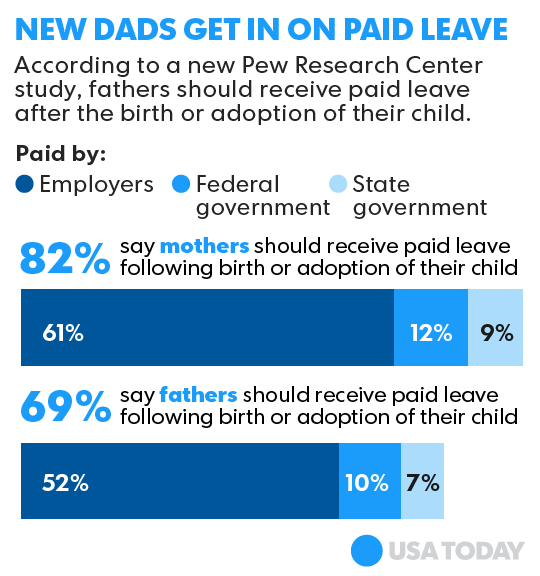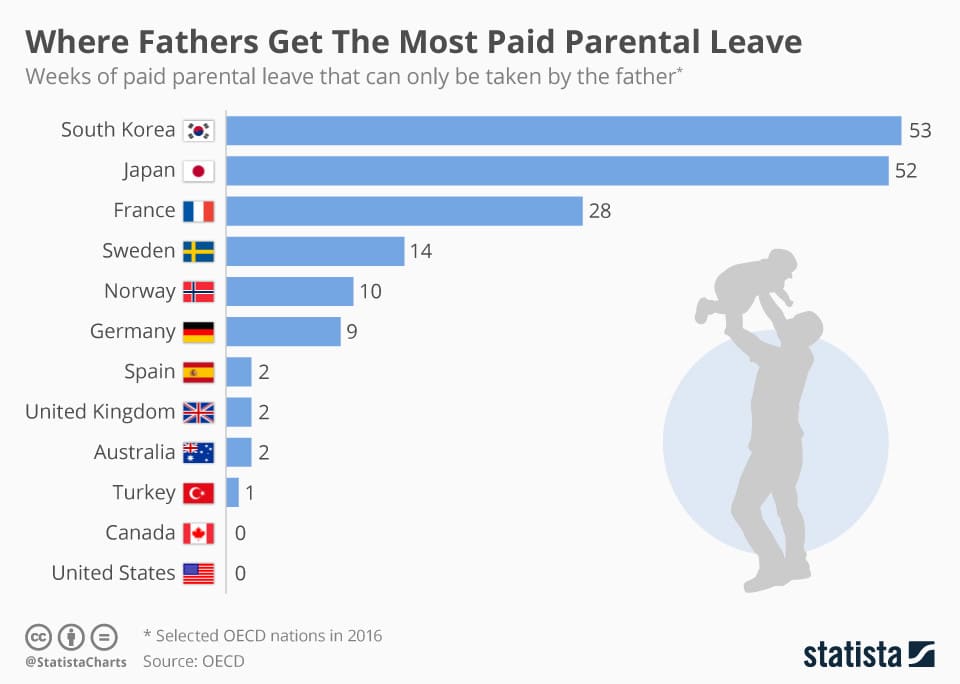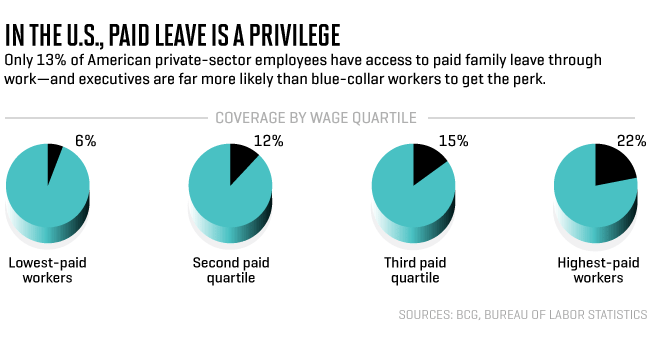The number of women who are working either full-time or part-time in the United States has increased substantially. Over the past half-century, the numbers have risen from 51% to 72%.
Another number indicates that approximately half of the two members’ families have two full-time working parents.
The above situation points towards the fact that the US is in urgent need of paid parental leave policy. Being one of the most developed nations in the world, it is truly a worrying sight that the country does not have a clear-cut parental leave act. There are a few laws regarding paid parental leave, but none of them is comprehensive.
What is Paternity Leave?
Paternity leave is the leave a father can avail to take time off from his employment after childbirth or adoption. It allows a father to spend quality time with his family. He can utilize this time to take care of both the child and the new mother.
This leave can have long-term implications and benefits, specifically in minimizing gender discrimination in workplaces. By ensuring that fathers are an active part of both maternity and childcare, they can change overly traditional mindsets. Paternity leave takes away from the antiquated notion that the mother is the primary caregiver to children and the father only needs to babysit occasionally to show their presence.
This time can be pivotal for both parents and can bring families closer together. It has been found that fathers who take an active role in raising their child in the formative years are more empathetic.
How does Paternity leave differ from Maternity Leave?
Maternity leave refers to the leave taken by the mother during the birth/adoption of their child.
Paternity leave is the one taken by fathers during the same time.
But both these terms are gendered and ignore the needs of non-traditional families. Societies are moving away from these gendered leave types to more inclusive ones.
Although, it should be noted that even paid maternity leave is not federally mandated in the United States. With more than 120 countries across the world providing paid maternity leave, we’re certainly not doing too well.
Parental leave policies are the alternatives to these gendered leave types. It enshrines child-rearing as a gender-neutral activity and also takes complex adoption processes into consideration.
Is Paternity Leave Required for Gender-Parity in the Workplace?
Paternity leave is a useful provision and a major life-changer for both men and women.
But you might have observed that while most businesses have some type of maternity leave policies, very few offer substantial paternity benefits. Why? Well, often management feels that it’s the woman’s job to care of the children. While obviously there is a biological aspect to this, raising a child is as much a job for fathers as it is for mothers.
Several reputable companies like Microsoft, Netflix and Amazon., have announced or revamped their existing paternity leave policy. Undoubtedly, this has introduced a sense of equality in the workplace. But the journey has just begun. According to a study by the Society of Human Resource Management, 29% of the organizations surveyed offered maternity and paternity leaves, whereas 58% offered maternity leave benefits only.
Are Paternity Leaves Encouraged?
But unfortunately, even the companies that offer paternity leave benefits do not really encourage employees to take them. When men enquire about such leaves, they are told that these leaves are only available “on paper”. The provision makes the company look good, irrespective of whether men are allowed to avail them or not.
Most new fathers admit that they fear they will be fired or lose promotions if they take paternity leaves. As per a survey by Dove Men + Care, 73% of the fathers said their workplace does not support new dads. 21% said they face the risk of getting fired from the company.
Most fathers who take parental leaves return to work within a week or two. A study has indicated that at least 76% of them return to their office within two weeks. Men fear that if they avail themselves long paternity leaves, it might have unfavorable consequences for their careers. A fear that most new mothers face too.

Changing Family Structures Need Parental Leave
A 2016 survey by PwC found that 54% of the men among those surveyed felt that work-life balance was important to them, while 64% of women felt the same. With changing family structures, the definition of childcare is also gradually changing. Men want to participate in raising their children actively. And for this, they want support from their employers and the government.
Although offering paternity leave is a step in the right direction, companies need to introduce a common leave policy for both men and women. With the definition of families changing rapidly in our society, parental leave must be the standard terminology.
What about the Paternity leave in the US?
Though healthcare and even policymakers have always been in favor of paternity leave in the US, only a few states and cities have passed the paternity benefit law. As per a UNICEF study in 2019, out of the 41 wealthy countries studied, only 26 had paid leaves for fathers, which obviously did not include the United States.
Organization for Economic Cooperation and Development also conducted a study in 2018 which shows that the US features dead last in parental leave laws. The study pointed out that 41 countries offer paid paternity benefits ranging from 2 to 30 weeks.
Although there are a few US states who have a state-mandated paid leave policy in place, there isn’t one on the national level.
Lack of paid paternity time hurts children, parents and society as a whole. Although federally, the United States does not have a paid leave law, they do have some that provide parental leave benefits. Let’s dive deep and understand what those entail.

Laws and Policies for Parental Benefit in the US
These are the major laws that are related to parental benefits in the US:
- Pregnancy Discrimination Act
- Family & Medical Leave Act
- Federal Employee Paid Leave Act
The first two laws have helped millions of families spend quality time with their children by availing of the benefits of both maternity and paternity leaves.
Pregnancy Discrimination Act
The Pregnancy Discrimination Act is one of the first laws that took care of pregnant women in the workplace.
The law states that if a woman is pregnant, her employer cannot deny her promotions, fire her, or refuse to hire her. The law also mentions that the employer must show consideration for pregnant women similar to an employee who is disabled or ill. If the company has paid sick days or disability benefits, a pregnant woman must be allowed to take them without any repercussions.
Although the Pregnancy Discrimination Act act does not offer job protection it prevents job discrimination. This act has helped several women overcome the discrimination they face at the workplace due to their pregnancy.
But since this law does not offer post-partum job protection, many women lose their jobs as soon as they rejoin the workforce.
Family & Medical Leave Act
A federal law that protects the job of millions of new mothers and fathers. This law has offered much-needed relief for parents during childbirth or adoption. The law came into existence in 1993, and since then, it has protected the rights of at least 50 million families. The law provides time off or leaves to parents with a few conditions. FMLA only covers:
- Individuals who have been working with the employer for at least a year and worked for a minimum of 1250 hours over the year
- Companies where the minimum employee strength is 50
- FMLA offers pre-approved unpaid leaves ranging from four to 12 weeks. When the leave period is about to end, the employee must inform the employer and rejoin at the same pay scale. The position can be different, but the pay scale must be the same. At least 40% of US companies are not covered under the FMLA paternity leave.
There is still a large portion of the US workforce who cannot opt for FMLA and risk losing their jobs. This can disproportionately affect women due to the biological considerations of maternity leaves.
Federal Employee Paid Leave Act
One of the main areas where the Family and Medical Leave Act and Pregnancy Discrimination Act lack is that they are both unpaid benefits. Under FEPLA, applicable federal employees eligible for FMLA become automatically eligible for 12 weeks of paid leave. The best part? The leaves are just paternity leaves or maternity leaves, they’re parental leave. This law covers only some specific categories of federal civilian employees.
But federal employees are only a very small part of the overall Americal workforce, where paid parental leave remains elusive to most. According to a National Compensation Survey in 2019, less than 1 in 5 employees get paid parental leave. This figure becomes even smaller in the case of low-wage workers.

State-Wise Paternity Leave Pay in the US
Currently, only five states in the US have mandated parental leave pay.
California Parental Leave
Starting from 2002, California was the first state to pass the first-ever parental leave law in America. The law finally came into force in 2004, and it was estimated that at least 45% of the new parents received their wages for a minimum of six weeks. Gradually in 2018, the percentage increased to 80%. In 2021, the California parental leave is extended to parents whose family members are deployed overseas. But one of the major demerits of this parental leave is that it does not offer job protection.
New Jersey Parental Leave
Next comes the New Jersey paid parental leave law passed in 2008 that came into force in 2009. As per the Garden’s State Program, at least 85% of the parents have availed of their parental leave benefits.
Rhode Island Parental Leave
Rhode Island passed a family leave law in 2013, which came into effect in 2014. It is one of a few states that provide paid time off for employees through its temporary disability and temporary caregiver insurance programs. Parents can receive up to four weeks of job-protected benefits from this.
New York Parental Leave
One of the most generous parental leave policies in the country. In NYC, new parents can avail themselves of paid benefits for up to eight weeks along with job protection.
Washington State Parental Leave
The Washington State paternity leave law was passed in 2007, but it came into existence in 2020. With this law, you get 12 weeks of paid leave. Workers who have worked for a minimum of 820 hours last year or 16 hours per week are covered under this law.
What are the Other US States Doing?
- Other than these states, Oregon, Colorado, Connecticut, and Massachusetts are covered under state family leave laws that will come into force from 2023, 2024, 2022, and 2021, respectively.
- City governments of Miami Beach, Chicago, Atlanta, Hoboken, Boston, Austin, Nashville, Salt Lake City, Pittsburgh, and Kansas City have paid maternity and paternity leaves for municipal employees.
How are US States Funding Paid Parental Leave?
Without federal funding and mandates, a lot of companies don’t want to spend considerable money on parental leaves. But state-mandated parental leaves are unique and funded differently. Both the employee and the employer contribute some percentage of the employee’s pay to a parental leave fund. At the time of parental leave, this fund is availed and the employee gets paid for their time off.
What’s Your Take on Paternity Leave?
Parental leave is beneficial to both employers and employees. It is high time that it be federally mandated. Childbirth and adoption come with their own set of challenges. A new addition to the family unit is stressful enough without the additional burden of no pay.
These leaves are an important contributor to employee engagement and retention. Employees who have access to paid leave, especially in the United States, are more loyal to their companies.
A parental leave policy holds the key to equality within families and workplaces both.
We have tried to cover all the different laws and states where paternity leave currently exists in the United States. Let us know @HarmonizeHQ if you have anything else to add, we would love to hear from you.



